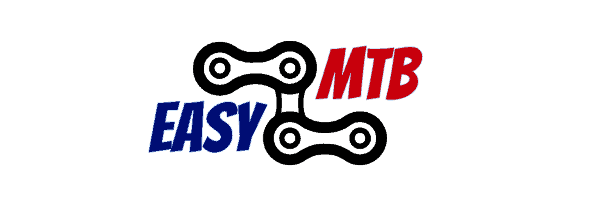One of the coolest things about mountain bikes is that you can ride these bikes practically anywhere, and in any condition. Although to best enjoy MTB, the gear that you wear truly does play a part in the overall enjoyment process of the sport. Shoes are undoubtedly the most important type of MTB gear next to helmets, and many novice mountain bikers often overlook this important fact. So, what are the best shoes for mountain biking?
The best types of shoes to consider for mountain biking are either a sturdy and popular brand of trail shoe or, an equally sturdy and well-known pair of winterized trail shoes that are designed to maintain durability and keep the feet as dry as possible when out in the wilderness.
Comfort is also a big thing to keep in mind when it comes to the best kinds of shoes for mountain biking. In this guide, we will take a closer look at how the importance of what shoe you choose to wear can affect your overall MTB enjoyment. We will also take a look at the best types of shoes for mountain biking and answer a range of questions as to whether you can use other types of outdoor shoes for MTB. Read on to find out more.
- Regular fit, Lace closure
- Fast-drying synthetic upper, Textile lining; Stealth S1 rubber outsole for unbeatable grip
- Medium-flex molded EVA midsole; Enjoy the comfort and performance of OrthoLite sockliner, Impact-resistant Poron toe box
- Benefit: Stealth, Flats
- Material: Synthetics, Weight: 12.2 oz (345 gm)
Prices pulled from the Amazon Product Advertising API on:
Product prices and availability are accurate as of the date/time indicated and are subject to change. Any price and availability information displayed on [relevant Amazon Site(s), as applicable] at the time of purchase will apply to the purchase of this product.
What Shoes Are Good For Mountain Biking?
So why exactly do you need shoes specially made for mountain biking? It really comes down to the wear and tear from pedaling and the outdoor elements. There are already a variety of shoes out there, such as running shoes or tennis shoes, so buying another pair seems redundant. But in truth, you would do well to invest in a good pair of MTB shoes simply because they’re the right tools for the task at hand.
Just as you wouldn’t use boots to try out for tap dancing, so you shouldn’t use running or tennis shoes when you go MTB. To break this down, this is so because when you bike, you only have three points of contact at most: your hands, your feet, and your rear end. When you stand, which you no doubt will when MTB, the points of contact drop to two. Seeing how crucial maintaining these points of contact are, selecting the appropriate footwear is worth every penny.
MTB shoes have a few advantages over regular shoes. There are two kinds, those for clipless pedals and those for flat pedals. Whichever kind you get, though, they’ll both have sturdy soles and provide foot protection so that fatigue is reduced and power transfer is maximized.
There isn’t a single best MTB shoe for all bikers out there, so it can get confusing choosing what kind of shoes to wear mountain biking. Weather, fitness, terrain, pedal preference, and riding styles all vary.
In the earliest days of mountain biking, cages and straps were on the fronts of pedals. Toes would slip into the cage, the strap would go over the foot, and lo and behold, you would then have toe clips. They were there to provide foot security, and kept feet from slipping away and helped with pedaling efficiency.
However, the downside though was that your foot would be stuck there. Whether you wanted to or not, yourself and the bike were one. If your bike crashed or flipped, then you were going with it. Time passed and pedal makers got smarter, to the point where in the first half of the 1990s, the Shimano Pedaling Dynamics (SPD) pedal by Shimano burst into the market.

A major feature of this new dynamic was the first clip-free MTB pedal. They were so named because, you guessed it, they had no toe clips. Instead, this pedal needed shoe soles with cleats that could screw into it. The cleat locks in on the pedal, yet riders could easily get off by twisting their heels out. This was very useful for when riders needed to quickly disengage from their crashing bikes.
Therefore, the two main types of MTB shows available are the flat type, which is usually made of aluminum and has large platforms for foot support and rows of pins for better friction. You won’t need special shoes with these.
And the second main type of MTB shoes are clipless, and this variety has an indent for cleats. Clipless types require special shoes to lock into them.
Ultimately, whichever type of MTB shoe you pick, it will come with disadvantages and advantages. Neither one is inherently better, but we’ve observed that riders tend to be in a rush to switch from flat pedals to clipless ones.
When you do this, you may end up masking some faults in your form and technique that will come back to haunt you in the future. On top of this, beginner mountain bikers will have an easier time learning how to ride if they start with flat-designed pedals because with them, you can quickly dismount if necessary.
What Are The Best Shoes For Mountain Biking
As mentioned, there are two types of mountain bike pedals, clip-in and flat, and to get the maximum performance from either, it’s necessary to use a dedicated shoe. Since both pedal systems are equally popular, it really comes down to which type best suits your performance dynamics.
Increasingly, there is also a crossover with newly released shoes, as brands design both clip-in and flat versions of the latest models. However, some companies still specialize in one particular type, such as Adidas Five Ten for example. You may be wondering if these particular dynamics make the shoes better, well, not necessarily, but judging by past experience, it does seem to be easier to make a decent clip-in shoe than one designed for a flat pedal.
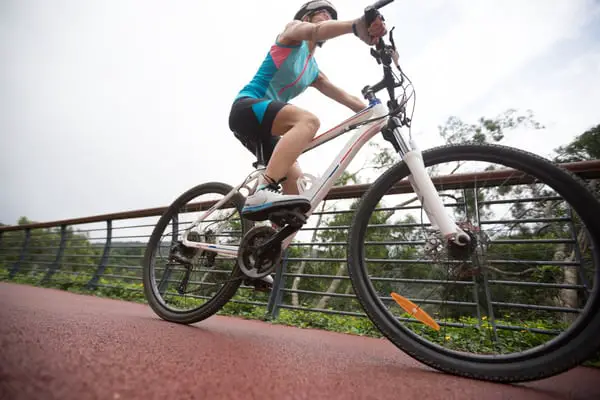
Of course, there is nothing stopping some riders from simply wearing flats in a pair of trainers. However, the shock-absorbing sole will sap energy, the rubber outsole will be too hard and slide on the platform, and the upper will not have enough support, if this makes sense.
So it’s just as crucial to use a specific MTB flat pedal shoe as it is a clip-in design. With more grip comes more control over the bike, and your feet are less likely to slip off, which is obviously a lot safer.
With clip-in pedals, any SPD-compatible shoe is going to work well because it’s actually the pedal/cleat interface that is responsible for grip and security. That said, a clip-in shoe is under more load when pedaling and during the disengagement phase, and often is supported by a smaller surface area of pedal, so it needs to feature a more stable construction and often a reinforcing strap to reduce flex.
Check out this article that explains the exact science behind MTB shoe dynamics.
Best Shoes For Mountain Biking Flat Pedals
Your feet are one of the most important contact points between yourself and your bike, so if you’re riding with flat pedals, choosing the best MTB flat pedal shoes can make or break your ride.
In our experience, riding with flat pedals can be a great way to hone the correct technique, boost rider confidence and form a new level of trail feedback communication to the rider, especially when paired with the best MTB flat pedals. Oh, and dropping a foot in your favorite turn is a pretty good feeling too.
We are big fans of riding with flat pedals and know exactly what to look for in a riding shoe to keep your feet glued to the pedals while maximizing feel and comfort on the trail.
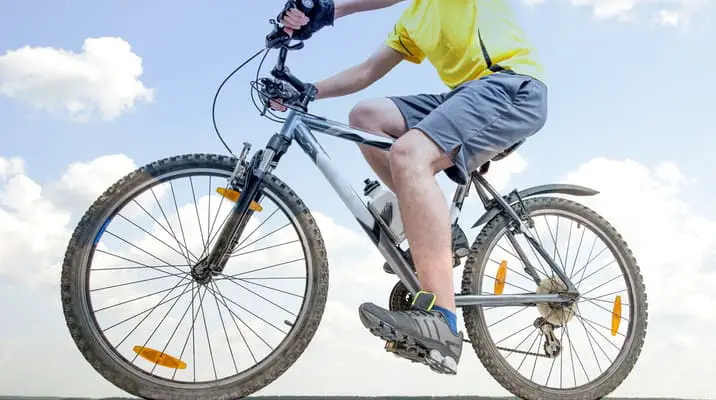
With this in mind, one of the best brands to consider is the Bontrager Flatline. Bontrager’s Flatline shoe uses a super sticky rubber on the sole that’s on par with Five Ten’s Stealth rubber compound so you won’t be lacking any grip. The upper portion of the shoe is weather-resistant, and as a whole, the shoe is flexible enough so that you feel in control without giving up any support.
In addition to great grip, these shoes are durable, comfortable, and reasonably weather-resistant. Even though previous Bontrager shoes were on the tighter side, the sizing on these runs large, so definitely try a pair on before you buy, and the long laces can get a bit annoying too. However, it’s good to know that Bontrager offers a 30-day return guarantee.
Good Shoes For Mountain Biking
When deciding on what shoes to wear mountain biking, aside from the dedicated MTB shoes, are there any other shoes you could use for mountain biking? It turns out that some people have found a happy medium without buying a specific MTB shoe.
If you skate, then your skate shoes might be a comfortable fit for your mountain bike. Many people stand by Vans as their startup MTB shoe, but these are generally for short-distance riding or use in bike parks, where you’ll be dismounting a lot.
Skate shoes have a grippy tread which maximizes surface connection on the pedal. The downside is that they probably don’t provide enough protection for your feet, which in all honesty, is totally fine for some trails, but for others, you want something that has material strong enough to withstand stabbing branches and flying stones.
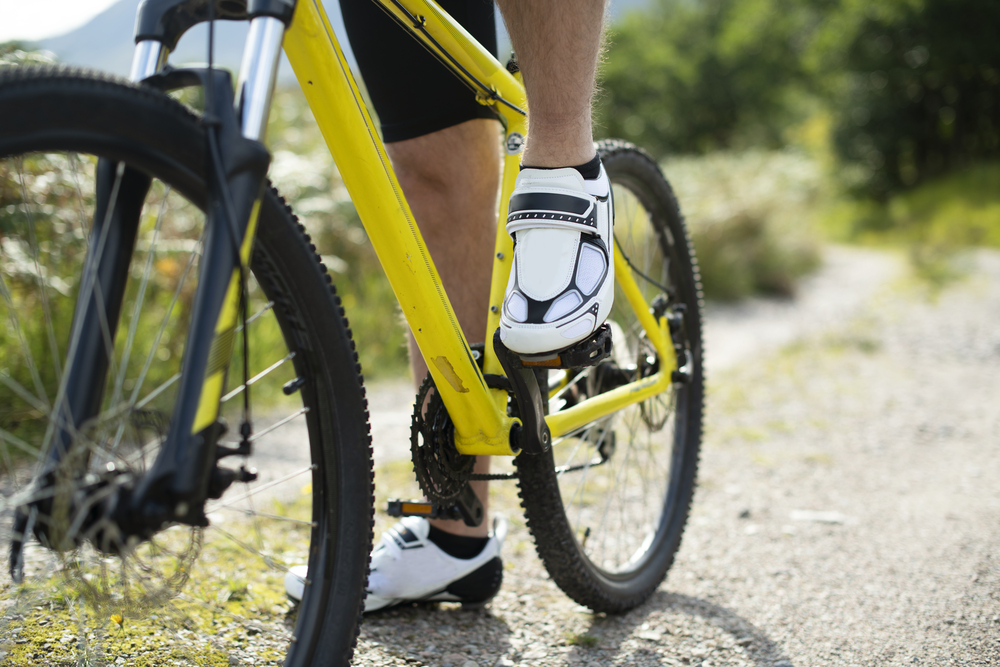
Some people even use their tennis shoes for mountain biking, which also have plenty of grip. However, tennis shoes may also be too flexible and won’t provide good enough support for mountain biking.
But even considering all of these details, don’t go out and buy these alternatives if you don’t already have them. If you’re a beginner, use what you’ve got and save up for better shoes in the future. Anything with a small, grippy tread that provides decent protection to your foot will do. Standard sneakers are a good starting point but by no means the perfect shoe for mountain biking.
So, just make sure the shoes you use are durable and somewhat compatible to the outdoors.
Can I Use Hiking Shoes For Mountain Biking?
Would hiking shoes be a good alternative for MTB? Yes, but not all the time. If you’re riding on smooth trails or even light dirt, then your hiking shoes will work fine. However, if you’re going to be on rocky or mostly downhill trails that require more power from the foot pedals, then you should wear a pair of dedicated mountain biking boots with clipless pedals attached or MTB flat shoes with superior rubber soles.
It’s possible to mountain bike in hiking shoes, but it is not recommended. It can cause serious or permanent injury if you use these shoes and your feet slip on the pedals. The best solution is to invest in some mountain bike specific shoes.
Hiking boots have been a favorite choice of riders for years. They offer a lot of features that make them appealing to the outdoor enthusiasts. However, they don’t fare well in wet and muddy conditions.
It is a common misconception that waterproof hiking boots are always better for mountain biking than regular shoes. In wet and muddy conditions, hiking boots offer less protection from dirt, mud and water. For this reason, many riders opt for waterproofed shoes as an alternative.
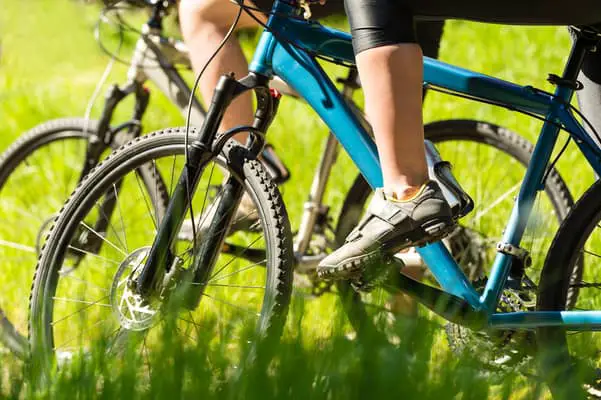
While some may claim that waterproof hiking shoes are the best option as they provide maximum protection from water and mud, it is important to note that they’re not always the best option as they offer less protection from dirt and mud.
Hiking shoes are designed for walking, not for biking or running. But, these shoes can work if you are doing a very mild bike ride in fair weather. The shoes will provide cushioning and support while the soles have slip-resistant grip.
When it comes to mountain biking, you need to know the type of terrain you’ll be riding on so that you can get the appropriate pair of shoes. When choosing your MTB shoes, consider how much grip they offer and how much protection they provide when riding over rocks and roots.
Can I Use Vans For Mountain Biking?
Vans are good for cycling because they have a superior waffle pattern grip that offers great traction and a flat sole that is ideal for bike pedals. With this in mind, avoid using slip-on Vans as these can come off your feet easily while riding. Use the lace-up version if you want more protection around your ankles.
Vans are commonly known as skater shoes with the reason being that skateboarding is where they first hit the scene. Since then they have taken over and people wear Vans in many situations today. There are a few features that make them good for cycling but also some that may not be safe.
One thing that never changes with Vans is the waffle pattern sole that you find on every pair of Vans shoes. This waffle pattern gives Vans the grip you can rely on for skateboarding and as it happens, for cycling too. Grip matters in cycling, because it contributes to pedal power which is the only way to create momentum and move forward. Without a good grip, your feet will constantly slide off the pedals.
This not only risks injury but will slow down any momentum you are trying to create. The waffle pattern sole offers great traction, so your feet stay in place. This includes staying put on the pedals. Beyond the grip, Vans have one feature that makes them great for cycling. The flat sole is perfect for fitting against flat pedals.
The lack of arch with Vans shoes makes them questionable for long walks, but with cycling, they fit well against pedals. Combined with the grip, Vans will keep your feet in place as you pedal.
Can I Use Trail Running Shoes For Mountain Biking?
If you have a pair of trail shoes, the good news is that you don’t have to go out and buy yourself yet another pair of shoes if you’re new to mountain biking. But, like anything, sometimes it pays to specialize and get gear specific to your activity. Trail running shoes are lightweight and usually pretty comfortable.
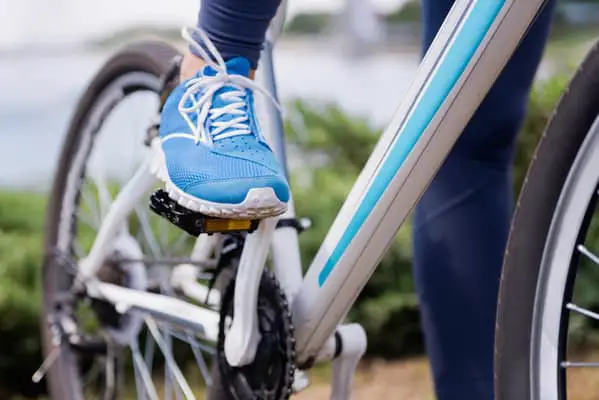
Some shoes are specialized for clipless pedals–if you are just using your trail running shoes you’ll easily be able to hop off your bike mid-ride and walk off to a viewpoint for a photo without having to change out of your specialized cycling shoes. Additionally, trail shoes are convenient, and one shoe that does it all means that you won’t clutter your house with tons of footwear.
Mountain biking shoes can range upwards of hundreds of dollars, therefore it’s nice to be able to forego yet another gear purchase if you have a durable pair of trail shoes.
With that being said, trail running shoes are great for support around your ankle, but they are made flexible underfoot to allow for the bending and movement of your foot. This suits a runner, but not a cyclist. Trail running shoes won’t provide the proper support at the base of the foot, which needs to be solid and relatively inflexible to spread your weight as you come crashing down on your pedals (or the ground) while riding on rough terrain.
Additionally, trail running shoes often don’t make any attempt to prevent your feet from getting wet. Even waterproof trail running shoes are low cut, so one step in a river will give you a soggy shoe for the rest of your run. If you’re mountain biking you can get away with heavier, more waterproof shoes if you need them.
The treading on a trail running shoe is grippy and perfect for dirt and rocks, but not in a way that perfectly suits mountain biking. The trail running shoe has a rather large, deep impression (instead of being a flat surface). The ridges on these shoes don’t sit too well on a flat pedal, and the shoes can more easily slip, resulting in an excruciating bite to the shins from your pedals.
And finally, flat pedals are designed to really grip your shoes and can shred the lugs of your trail running shoe.
Trail running shoes are okay for MTB, but certainly not ideal.
How To Keep Feet Dry Mountain Biking
When riding your mountain bike on a day dominated by sub-zero/freezing temperatures, nothing feels nicer than warmth in your feet. That’s why you need to invest in a pair of the best winter shoes for mountain biking.
The best of the finest winter cycling shoes for MTB are almost always pricey. Even worse, they’re winter-specific shoes. That means these shoes can bake your feet if worn for summer riding. But if you’re willing to look beyond a high price tag and the shoes being somewhat limited, there’s a boatload of great options out there.
In all honesty, it is best to read a few real-world reviews before buying, though. Make sure to pick up shoes that actually keep cold feet warm even on the harshest days in the mountains.
If you like, you can buy an all-weather cycling shoe that comes with two kinds of insoles. These shoes come with thinner, perforated, breathable summer insoles. The other sole type these shoes offer is designed for winter riding and is super thick and warm.
With such a shoe, just put in the winter insoles when the cool season comes around. And use the thinner, perforated insoles when it’s sunny and dry outside.
But you don’t have to buy this kind of biking shoe if you don’t want to for some reason. You could always grab a pair of proper winter mountain biking insoles at your local drug store.
How To Keep Your Feet Warm Mountain Biking
Doing MTB during winter can be particularly harsh on the feet. Those who are at the end of their rope tend to focus too much on their feet. This is, after all, where you experience the most discomfort. So the natural way of troubleshooting this is by layering on multiple pairs of socks and calling it a day.
But what people seldom realize is that most of our body heat escapes through the head and neck, or any part that’s exposed. Similarly, when we start losing warmth in the torso, the body’s natural response is to pull heat through the extremities by reducing the blood flow to them.
When your body kicks into survival mode, its top priority is to keep your vital organs insulated.
Since we don’t have vital organs down south, our limbs won’t receive a regular amount of blood flow if the rest of your body starts freezing up. One of the most common mistakes to make during the winter is overdressing, and not the fashion type of mistake. Overdressing is just as bad as underdressing. Ideally, you want to be slightly cold when you get into your gear.
It will take your body a couple of minutes to acclimate to the weather outside, but cycling will warm up your body soon enough. Being too toasty is actually counterintuitive. By piling on layer upon layer of winter clothing, you may start sweating too much, and this could lead to hypothermia by way of dehydration.
In summary, it is just as important to protect the rest of your body as it is to bundle your feet in socks.
- Regular fit, Lace closure
- Fast-drying synthetic upper, Textile lining; Stealth S1 rubber outsole for unbeatable grip
- Medium-flex molded EVA midsole; Enjoy the comfort and performance of OrthoLite sockliner, Impact-resistant Poron toe box
- Benefit: Stealth, Flats
- Material: Synthetics, Weight: 12.2 oz (345 gm)
Prices pulled from the Amazon Product Advertising API on:
Product prices and availability are accurate as of the date/time indicated and are subject to change. Any price and availability information displayed on [relevant Amazon Site(s), as applicable] at the time of purchase will apply to the purchase of this product.
